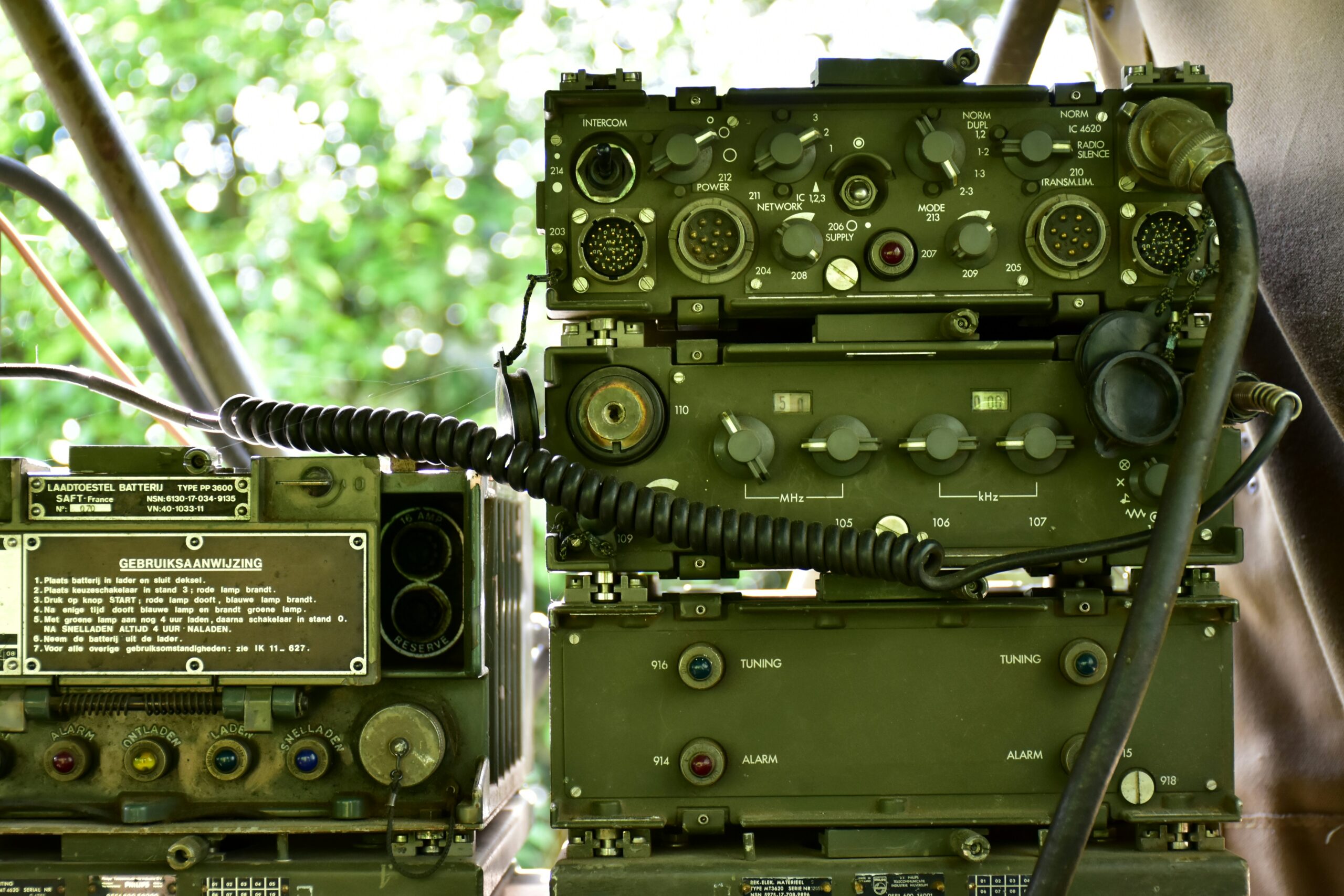R-168: The Russian Military Radio That’s Not So Russian

Moscow sells the R-168 as proof its army can talk under fire without outside help. Documents and captured sets prove many key chips ship in from abroad. That clash between message and material defines its whole tale.
From Design Brief to Factory Floor
Late 1990s, the Defense Ministry wrote a tight spec sheet. Crews needed fresh gear that could:
- Hop frequencies fast, outrunning jammers.
- Encrypt voice and data, blocking easy eavesdrop.
- Swap modules quick, so field techs fix breaks with only screwdriver.
Budget landed, labs in St. Petersburg drew first boards. Engineers planned to lean only on Russian parts, but fab lines back then sat a full tech cycle behind US and Japan. Workarounds crept in. By 2002 first vehicle sets rolled out the gate. Manuals listed every block as “domestic,” though labels under conformal coat already told different story.
Early Parade Shine, Hidden Rust
Brand-new radios sat on BMP-3 roofs during the 2003 Victory Day march. Footage showed green faceplates and bright LCDs. Maintenance sheets filed weeks later showed cracked solder joints and fogged screens after a Siberian cold soak. Crews kept units running, yet they logged:
- loose knob collars;
- seals pulling off edges;
- battery packs draining too quick under −20 °C.
No press piece covered those notes. Ministry memos sure did.
Supply Chain Reality Surfaces
By 2014 hobby analysts bought surplus boards, scraped epoxy, snapped macro photos. Marks read Texas Instruments, Xilinx, Murata. When fighting in Ukraine began, captured sets exposed even more Western-origin chips. Boards carried:
- TI AM335x digital signal cores
- Xilinx Spartan-6 FPGAs
- Analog Devices ADC chips
- Murata CERAFIL filters
Each chip type filled gap Russian fabs could not yet match on line width, noise floor, or power draw. Without them, claimed spec sheet would slump.
Why Imports Beat Pure Local
Russian lithography sat at 65 nm node. That means bigger transistors, hotter die, slower clocks. Agile waveforms need tight timing—hard to get on thick silicon. Designers weighed two bad choices: accept larger radios with cut range, or pull in foreign die under hush. They picked second path. Public statements kept phrase “fully domestic,” yet requisition forms attached to every lot listed “special components” by code only insiders decode.
Field Experience 2022-2024
Once missiles flew, spectrum turned hostile. Ukrainian EW stations flooded bands with noise. Reports from both sides show practical limits:
- Range fell by third when blanket jamming rose past 50 W ERP.
- Legacy GOST-based cipher keys rolled slower than plan, letting analysts brute-force some traffic.
- Heat inside armored cabins nudged reference oscillators off spec, causing desync until cool-down.
Work crews answered by doubling antenna swaps and cutting chatter length, yet stress kept creeping.
Jam Tactics Meet Patch-Work Comms
Units shifted to layered system: main call on R-168, backup on older R-173, last resort on cheap civilian walkie sets. That mix wastes time and training hours, but loss of link hurts more. After each mission, logistics officers checked board spares; sanction pressure meant only partial refill. Some brigades stored dead sets as donor boards, a practice last common in 1980s Soviet fleet.
Sanctions and Shadow Imports
2014 sanctions slowed chip stream, 2022 made flow worse. Brokers pivoted through:
- UAE free-zone re-labels
- Armenian transit hubs
- Hong Kong-to-Vladivostok cargo routes
Custom codes read “industrial controller,” “test evaluation kit,” anything but “military radio core.” Western enforcement kept shutting doors, so paths kept shifting. Result: erratic delivery times, mismatched lot codes, rising failure rates right out of crate. These tactics, however, have also impacted other programs, including optical and sensor projects tied to licensed thermal imager production for armored vehicles.
Domestic Fab Push
Government pledged two new fabs—Nizhny Novgorod and Zelenograd. Target node: 28 nm. Building shell was easy, tool install not. EUV steppers embargoed, so managers chased older DUV lines. By 2024 pilot wafers started, yield low, cost high. Engineers swapped to 40 nm plan for interim boards. That cut data rate 20 %, yet beat no radio at all.
R-187 “Azart” Tries to Leap Ahead
While R-168 kept frontline slot, industry launched R-187. Folder claims:
- half the weight,
- touchscreen UI,
- mesh routing across squads.
Trials showed new set falls short on battery life, overheat at 45 °C cabin temp, and mis-link with legacy nets. Command kept orders small, telling units to run both models. Logistics strain grew again.
Reliability Under Heat and Dust
Southern axis fighting put radios inside T-72 hulls under 55 °C. Data logs pulled later show internal PCB zones hit 95 °C peak, well past TI data-sheet max. Bit errors spiked; voice frames dropped. Crews learned to crack hatches after long idles, but that exposes them to sniper glare. Simple but risky trade.
Export Sales, Limited Uptake
Russia offered R-168 to Belarus, Syria, Algeria. Deals stayed thin. Buyers weighed spare parts risk: if Washington tightens lists, chips stop. Chinese vendors push Norinco NR-900 sets with full supply guarantee; many clients took that safer route. Low export revenue loops back, starves R-168 upgrade money.
March 2025 Update
Kremlin media aired a clip of “R-168 F-5”—claimed 100 % Russian silicon. TV zoom never lingered on chip stamps. Insiders note new FPGA built at state plant on 40 nm. Early brigade issue saw units boot faster, cipher keys rotate quicker. Two sets failed thermal stress day three; depot added bigger heat spread plate. Rollout schedule still vague.
Strategic Ripple
Comms weakness drags on all network-centric arms:
- Smart artillery needs precise target data flow.
- Recon drones stream video back on same band slice.
- Blue-force tracking markers sync through radio bursts.
If supply falters, each high-tech weapon downgrades to dumb mode — a vulnerability mirrored in other advanced Russian systems, from frontline radios to hypersonic assets like the Avangard glide vehicle. Enemy then gains edge without firing extra shot.
Steps Toward True Autonomy
Long-term plan demands:
- five-year R&D cash shielded from budget swings;
- joint lithography venture or in-house 14 nm line;
- trained design teams for DSP, RF front, firmware;
- rigorous QA chain from wafer test to bench burn-in.
Any slip pushes goalpost out again. Semiconductor ramp is marathon, not sprint, and sanctions act like extra sand in shoes.
Outlook
R-168 proves a radio can blend solid RF design with patch-work supply and still run, yet fragility sits right beneath panel screws. Until home fabs match foreign line widths, Russian units will guard a cardboard-thin lifeline of covert chips. Next clash could cut that line faster than staff planners expect. Whether fresh fabs or alliances fill the gap decides if future Russian squads speak clearly or fall back to hand signals.
REFERENCE SOURCES:
- https://sprotyvg7.com.ua/wp-content/uploads/2023/11/COGINT_Analytic_Insight_Report_Russian_EW_Systems__231119_114942.pdf
- https://wavellroom.com/2022/12/19/russian-army-tactical-communications/
- https://militarnyi.com/en/news/fbi-investigates-american-components-in-russian-military-equipment-wp/
- https://dsm.forecastinternational.com/2023/09/12/r-168-the-russian-military-radio-thats-not-so-russian/
- https://english.defensearabia.com/the-russian-armys-communication-challenges/
- https://www.armadainternational.com/2023/06/russian-military-communications/


